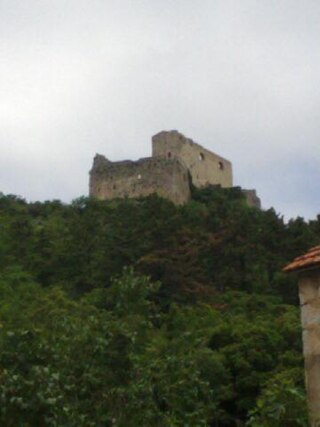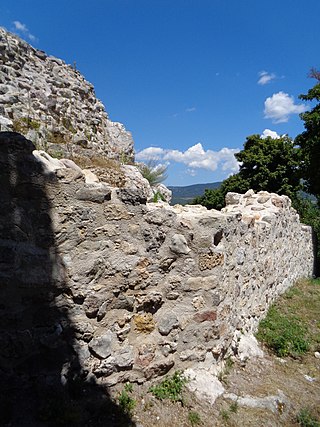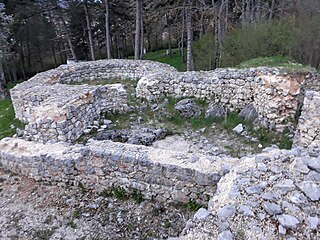
The House of Frankopan was a Croatian noble family, whose members were among the great landowner magnates and high officers of the Kingdom of Croatia in union with Hungary.

The Battle of Krbava Field was fought between the Ottoman Empire of Bayezid II and an army of the Kingdom of Croatia, at the time in personal union with the Kingdom of Hungary, on 9 September 1493, in the Krbava field, a part of the Lika region in Croatia.

Brinje is a municipality in Lika-Senj County, Croatia. It is located about 20 kilometres (12 mi) east of Senj and 60 kilometres (37 mi) north of Gospić.

Samobor Castle is a ruined castle atop of Tepec hill in Samobor, Croatia. It lies only a 10-minute walk away from the city centre. Remains of the old castle moat are still visible, as well as the massive entrance and most of the walls.

Ozalj Castle is a castle in the town of Ozalj, Croatia.

Grižane Castle is a ruined castle and site near Grižane in Vinodol, in the northern part of the Adriatic coast, western Croatia. The castle of Grižane had an odd, rectangular form with circular towers, and this irregularity was caused by the peculiar structure of the field.

Hreljin Castle is a fortress and castle near Hreljin, Croatia. It is located in the western part of Vinodol, in the hill above Bakarac, which served as its seaport. Hreljin is first mentioned in historical sources in 1225, when the Frankopan noblemen received it as a gift from the Croatian-Hungarian king Andrew II. It is one of the nine towns that signed the Vinodol Codex, one of the oldest Slavic codes, in 1288. After the Frankopans, it was owned by another noblemen family, the Zrinskis, from 1550 until the execution of Zrinskis and Frankopans in 1671. When Bakar was declared a Royal free city in 1778, Hreljin was under its rule, but already decaying. The last inhabitants were three priests who abandoned it in 1790.

Trsat Castle is a castle in Trsat, Croatia. It is thought that the castle lies at the exact spot of an ancient Illyrian and Roman fortress. The Croatian noble Vuk Krsto Frankopan is buried in one of the churches. The Trsat castle was completely reconstructed and renovated in the 19th century when the mausoleum of the military commander Laval Nugent was built in its interior. The courtyard of the castle has now been turned into a restaurant and many tourists visit the place during the summer months.

Prozor Fortress is a medieval fortress situated in the continental part of Split-Dalmatia County, in inland Dalmatia, just above the town of Vrlika in Croatia. From its origin as a small stronghold built by the ancient Illyrian tribe Dalmatae, it developed into a fortress in the 15th century, during the reign of Bosnian feudal lord Hrvoje Vukčić Hrvatinić.

Frankopan Castle is a castle located on the southwest coast of the island Krk, in the ancient town of Krk, which is one of the oldest towns in the Adriatic, in Croatia.

Čakovec Castle or Zrinski Castle is a medieval fortification in the middle of the town of Čakovec, the administrative seat of Međimurje County, northern Croatia.

Metlika Castle is a 15th-century castle located above the old part of the town of Metlika in southeastern Slovenia, very near the Croatian border.
Bribir is a village in the Primorje-Gorski Kotar County of Croatia. It is located near Crikvenica and Novi Vinodolski, in a valley 5 km from the Adriatic Sea. It has a population of 1,695 and the post code HR-51253. It is the seat of the Vinodol Municipality.

The Tržan Castle is a ruined medieval castle above the village of Modruš in the northern part of historical Lika region, central Croatia. Before the administrative seat of the former Modruš County, it is today a ruin in the Josipdol Municipality in the southern part of the Karlovac County.
Skrad (pronounced[skraːd] is a medieval ruined castle located on the right bank of the Korana river in modern Karlovac County, Croatia. It overlooks the river gorge from a small hill at the end of a larger hill, whose height above sea level is 430 m. It is roughly triangular in plan, and once included 6 towers, a church, and a number buildings, though today very little rises above grass-level. It was one of the larger castles in the region, though not quite as large as Modruše or Cetin.

Zvečaj is a medieval ruined castle located on the left bank of the Mrežnica river in modern Karlovac county, Croatia. Around it formed an eponymous village, today separated into upper and lower. It has a rectangular floorplan, with a central tower. It survived in good condition much longer than most castles in the region.
Sokolac is a municipality of the city of Istočno Sarajevo, Republika Srpska, Bosnia and Herzegovina.

Udbina Castle is a ruined medieval fortified structure in the town of Udbina, Lika-Senj County, Croatia. Built on the top of a hill at the northern end of the town, it overlooks a large part of the Krbava field, just above the place where the fierce and bloody Battle of Krbava between the army of the Kingdom of Croatia and the Ottoman Empire was fought in 1493. Once property of the powerful Kurjaković noble family, the castle was captured by the Ottomans in 1527. It was recaptured in 1689 by Habsburg-Croatian army, but later, by the end of the 19th century, uncared-for, the castle slowly turned into a ruin.

Fortica Fortress is a ruined early modern fortified structure in the town of Otočac, Lika-Senj County, Croatia. Built on the top of a flat hill at the northern end of the town, it overlooks a large part of Otočac and Gacka River valley. Once a military-defensive stronghold on the line of defense against Ottoman Turks, it turned later slowly, by the end of the Ottoman wars during the 19th century, being uncared-for, into a ruin. Recently, the fortress has been partially restored.

The siege of Sokolac was a siege of Sokolac Castle in Brinje, Kingdom of Croatia, in August 1493, by the joint bans of Croatia John Both de Bajna and Emerik Derenčin, against the Frankopan family, due to the Frankopans' attempt to regain control over the town of Senj. John Both was killed during the siege, and it was eventually abandoned after Derenčin received news of an approaching Ottoman army. The two sides made truce, and fought the Ottomans together at the Battle of Krbava Field the following month.























